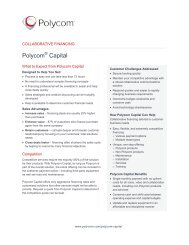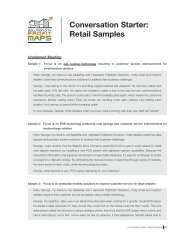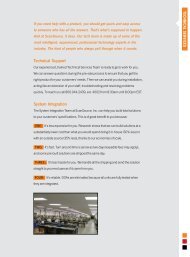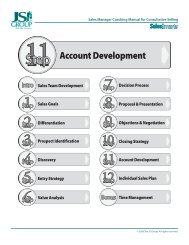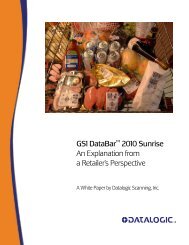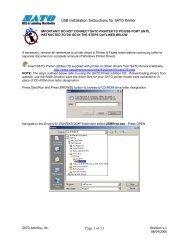Download PDF - ScanSource
Download PDF - ScanSource
Download PDF - ScanSource
You also want an ePaper? Increase the reach of your titles
YUMPU automatically turns print PDFs into web optimized ePapers that Google loves.
Critical Accounting Policies and Estimates<br />
Management’s discussion and analysis of financial condition and results of operations are based upon the Company’s consolidated financial statements, which have<br />
been prepared in conformity with accounting principles generally accepted in the United States of America. The preparation of financial statements requires management<br />
to make estimates and assumptions that affect the reported amounts of assets and liabilities and disclosure of contingent assets and liabilities at the date of the financial<br />
statements and the reported amounts of revenues and expenses during the reporting period. On an ongoing basis management evaluates its estimates, including those<br />
related to the allowance for uncollectible accounts receivable, inventory reserves to reduce inventories to the lower of cost or market, vendor incentives, goodwill and<br />
identifiable intangible assets, deferred taxes and contingencies. Management bases its estimates on historical experience and on various other assumptions that<br />
management believes to be reasonable under the circumstances, the results of which form a basis for making judgments about the carrying value of assets and liabilities<br />
that are not readily available from other sources. Actual results may differ materially from these estimates under different assumptions or conditions, however,<br />
management believes that its estimates, including those for the above-described items are reasonable and that the actual results will not vary significantly from the<br />
estimated amounts. For further discussion of our significant accounting policies, refer to Note 2 of Notes to Consolidated Financial Statements.<br />
Stock-Based Compensation<br />
A revised standard, Statement of Financial Accounting Standards (“SFAS”) No. 123 (revised 2004), Share Based Payment (“SFAS 123(R)”), which requires all<br />
companies to measure compensation cost for all share-based payments (including stock options) at fair value, was effective beginning with a company’s first interim or<br />
annual reporting period of the first fiscal year beginning on or after June 15, 2005. This means SFAS 123(R) was effective for the Company beginning with the first quarter<br />
of fiscal year 2006, which began on July 1, 2005. The adoption of SFAS 123(R) requires the Company to apply a valuation model, which includes estimates and<br />
assumptions on the rate of forfeiture and expected life of options and stock price volatility. Actual results may differ from estimates. See Note 2 to the Consolidated<br />
Financial Statements for additional information regarding the adoption of SFAS 123(R).<br />
Revenue Recognition<br />
Revenue is recognized once four criteria are met: (1) the Company must have persuasive evidence that an arrangement exists; (2) delivery must occur, which<br />
happens at the point of shipment (this includes the transfer of both title and risk of loss, provided that no significant obligations remain); (3) the price must be fixed and<br />
determinable; and (4) collectibility must be reasonably assured. A provision for estimated losses on returns is recorded at the time of sale based on historical experience.<br />
The Company has service revenue associated with configuration and marketing, which is recognized when the work is complete and all obligations are substantially<br />
met. The Company also sells third-party services, such as maintenance contracts. Since the company is acting as an agent for these services, revenue is recognized net of<br />
cost at the time of sale. Revenue from multiple element arrangements is allocated to the various elements based on the relative fair value of the elements, and each<br />
revenue cycle is considered a separate accounting unit with recognition of revenue based on the criteria met for the individual element of the multiple deliverables.<br />
Allowances for Trade and Notes Receivable<br />
The Company maintains an allowance for uncollectible accounts receivable for estimated losses resulting from customers’ failure to make payments on accounts<br />
receivable due to the Company. Management determines the estimate of the allowance for uncollectible accounts receivable by considering a number of factors,<br />
including: (1) historical experience, (2) aging of the accounts receivable and (3) specific information obtained by the Company on the financial condition and the current<br />
creditworthiness of its customers. If the financial condition of the Company’s customers were to deteriorate and reduce the ability of the Company’s customers to make<br />
payments on their accounts, the Company may be required to increase its allowance by recording additional bad debt expense. Likewise, should the financial condition of<br />
the Company’s customers improve and result in payments or settlements of previously reserved amounts, the Company may be required to record a reduction in bad debt<br />
expense to reverse the recorded allowance. A provision for estimated losses on returns and allowances is recorded at the time of sale based on historical experience.<br />
22






